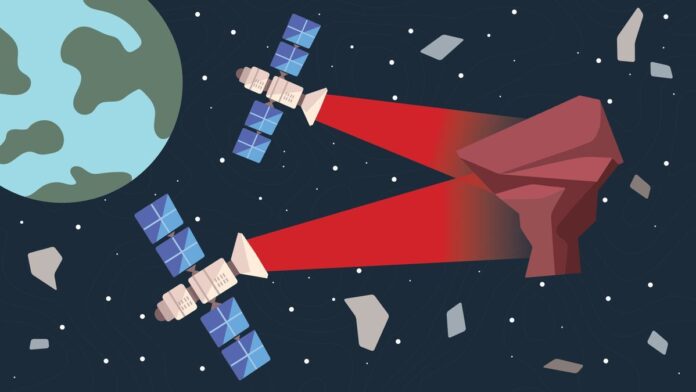Low-Earth orbit is teeming with space junk. This increasingly cluttered area of space could benefit from a network of lasers that nudge objects at risk of colliding with satellites or spacecraft into safer orbits, according to new research.
While space debris has been a concern for decades, efforts to address this junk have only recently started receiving serious investment. The latest early-stage idea is to mount artificial intelligence-powered lasers on satellites or other dedicated platforms and have them monitor space debris objects. When an object is suspected to be on a collision course with a valuable space asset like the International Space Station (ISS) or a satellite, the lasers could, in theory, nudge that object into a safer orbit.
“Our goal is to develop a network of reconfigurable space-based lasers, along with a suite of algorithms,” Hang Woon Lee, the director of Space Systems Operations Research Laboratory at West Virginia University who is leading the new project, said in a statement. “Those algorithms will be the enabling technology that make such a network possible and maximize its benefits.”
Related: Orbiting debris trackers could be a game changer in space junk monitoring
NASA is funding Lee’s idea with $200,000 across three years. Although the plan is still in its infancy, its ultimate goal is to develop a system capable of making real-time decisions about which space objects to target and to ensure the new orbits are actually safe from further collisions. Using multiple lasers is crucial to efficiently alter the object’s trajectory “in a way that would be impossible with a single laser,” Lee said in the same statement.
Measuring the amount of risk from space debris is quite difficult, as not every object in orbit is capable of being tracked. Humans have flown over 15,000 satellites since the 1950s, of which only about 4,000 are operational satellites, according to 2022 estimates. According to the European Space Agency (ESA), around 34,600 space debris fragments are currently tracked by radar systems on Earth, but another 130 million pieces could be in orbit that are too small to be accurately detected or tracked.
So unlike other space debris removal ideas, a coordinated network of lasers in space could be particularly useful in tackling a space object of any size, researchers say. In March, a NASA report found space-based lasers are advantageous compared to ground-based ones because they don’t need to pass through Earth’s atmosphere, which could deform the beams. Being in space, the beam can more easily pulse the target object into favored orbits, according to the report.
Such AI-powered systems are also beneficial in terms of cost and could eventually be used to track space objects ahead of launches, for example. Last week, Amazon delayed the launch of its first two prototype internet satellites by six minutes to avoid colliding with a space object. Back in July, India had delayed launching its historic Chandrayaan-3 moon mission by three seconds for the same reason.

